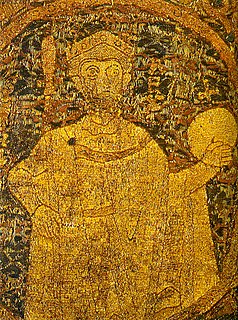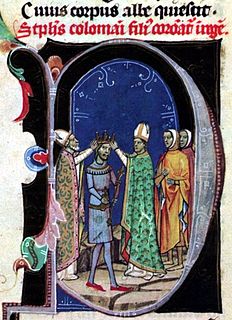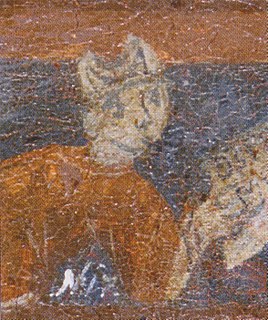Bibliography
- Beke, Margit (2003). Esztergomi érsekek 1001-2003. Szent István Társulat. ISBN 9789633614723.
Domonkos | |
|---|---|
| Archbishop of Esztergom | |
| Archdiocese | Archdiocese of Esztergom |
| Appointed | 1000 |
| Term ended | 1002 |
| Predecessor | Archdiocese founded |
| Successor | Sebestyén |
| Personal details | |
| Born | c. 954 (?) |
| Died | 1002 |
| Denomination | Roman Catholicism |
Domonkos or Domokos (died 1002), was a Hungarian Benedictine missionary, prelate and politician, who served as the first Archbishop of Esztergom between 1000 and 1002.
Date and exact place of his birth are unknown, but probably he was born around the year 954 in a region of Italy. About 1000 he was a Benedictine in Pannonhalma Archabbey. He was one of those who signed the letter of donation of the Abbey, along with King St. Stephen I. It is possible that he himself has crowned the Hungarian king as well, but no hard evidence exists of this. In 1001 St. Stephen founded the religious council of the archbishop of Esztergom, and the other six Hungarian bishoprics. Domonkos was also the Vice Chancellor of Stephen I, and coordinated evangelism of Hungary with many foreign priests. He died in 1002.

Stephen I, also known as King Saint Stephen, was the last Grand Prince of the Hungarians between 997 and 1000 or 1001, and the first King of Hungary from 1000 or 1001, until his death in 1038. The year of his birth is uncertain, but many details of his life suggest that he was born in, or after, 975, in Esztergom. At his birth, he was given the pagan name Vajk. The date of his baptism is unknown. He was the only son of Grand Prince Géza and his wife, Sarolt, who was descended from a prominent family of gyulas. Although both of his parents were baptized, Stephen was the first member of his family to become a devout Christian. He married Gisela of Bavaria, a scion of the imperial Ottonian dynasty.

The King of Hungary was the ruling head of state of the Kingdom of Hungary from 1000 to 1918. The style of title "Apostolic King of Hungary" was endorsed by Pope Clement XIII in 1758 and used afterwards by all Monarchs of Hungary.
Matthias from the kindred Rátót was a Hungarian prelate in the first half of the 13th century, who served as Bishop of Vác from 1238 to 1240, then Archbishop of Esztergom from 1239 until his death in the Battle of Mohi. He was the first Archbishop of Esztergom, who was referred to as Primate of Hungary.
Blessed Sebestyén, was a Hungarian Benedictine missionary, prelate and politician, who served as Archbishop of Esztergom between 1002 and 1007.
Domonkos or Domokos was a Hungarian prelate and politician, who served as Archbishop of Esztergom between 1037 and 1040. His name is appeared in a diploma of Bakonybél Abbey from 1037. He was the last archbishop for Stephen I of Hungary. According to the source, Domonkos II "share the King's problems of throne succession of uncertainty and conspiracies against the monarch".
Seraphin was a Hungarian prelate at the turn of the 11th and 12th centuries, who served as Archbishop of Esztergom from around 1095 until his death.
Nehemiah was a Hungarian prelate and politician, who served as Archbishop of Esztergom in the 1070s, during the reigns of Géza I and Ladislaus I of Hungary.
Macarius was a prelate in the Kingdom of Hungary in the first half of the 12th century. He was successively provost of Titel around 1127, bishop of Pécs between around 1136 and around 1139, and finally archbishop of Esztergom until around 1147.
Kalán from the kindred Bár-Kalán was a prelate and royal official in the Kingdom of Hungary at the turn of the 12th and 13th centuries. He was bishop of Pécs from 1186 until his death in 1218, and ban of Croatia and Dalmatia between 1193 and 1194, thus he was the first prelate in the kingdom to parallelly held a secular office. Kalán's relationship with the monarch was tense in the reign of King Emeric who accused the bishop of incest but could never prove it. Although a part of the canons of Esztergom elected Kalán as archbishop in 1204, his election was not confirmed by the Holy See. Kalán died when planning to go on a crusade to the Holy Land.

Robert was a French-born prelate in the Kingdom of Hungary in the first decades of the 13th century. He was Archbishop of Esztergom between 1226 and 1239 and Bishop of Veszprém from 1209 till 1226. He played a decisive role in the establishment of the short-lived Diocese of Cumania. He was sharply opposed to the employment of Jews and Muslims in the administration of the royal revenues. He even put Hungary under interdict to force Andrew II of Hungary to dismiss his non-Christian officials.
Apa or Appa was a nobleman in the Kingdom of Hungary in the second half of the 12th century, who held courtly positions and elevated into the dignity of Ban of Slavonia during the last period of the reign of Géza II of Hungary.
Marcellus was a Hungarian prelate at the turn of the 11th and 12th centuries, who served as Bishop of Vác from around 1111 to 1113, then Archbishop of Esztergom from around 1116 until his death.

Lawrence was a Hungarian prelate at the turn of the 11th and 12th centuries, who served as Archbishop of Esztergom from around 1105 until his death. He was a faithful confidant of Coloman, King of Hungary and the initiator of large-scale church organizational and canon law reforms in the Kingdom of Hungary.
Acha was a Hungarian prelate in the second half of the 11th century, who served as Archbishop of Esztergom from around 1087 to 1090.
Felician was a Hungarian prelate in the first half of the 12th century, who served as Archbishop of Esztergom from around 1125 until his presumably death in 1139 or later.
Martyrius or Martirius was a Hungarian prelate in the 12th century, who served as Bishop of Veszprém from around 1127 to 1137, Bishop of Eger from 1142 to 1150, and finally Archbishop of Esztergom from 1151 until his death.

Job was a Hungarian prelate at the turn of the 12th and 13th centuries, who served as Bishop of Vác from 1181 to 1183, and as Archbishop of Esztergom from 1185 until his death.
Nicholas (II) Vásári was a Hungarian prelate in the 14th century, who served as Archbishop of Esztergom from 1350 until his death.
Ded was a prelate in the Kingdom of Hungary in the 12th century, who served as Bishop of Vác during the reign of Géza II of Hungary.
Chama, also Sayna or Chemma, was a Hungarian prelate in the twelfth century. He was successively Bishop of Eger from 1158 to around 1166, then Archbishop of Kalocsa between around 1169 and 1171.